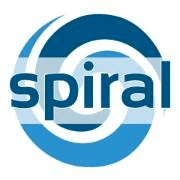 | ||
Profiles | ||
Spiral Binding Company, Inc. was started in 1932 as the first mechanical binding company in the United States. They created the original metal spiral-coil binding and later the Spiralastic, a popular plastic coil to replace wire during World War II. Spiral Binding acquired James Burn North America in 2007. James Burn North America was renamed James Burn USA.
Contents
1930s
In 1932 Frank Amato of Italy worked in a manufacturing metal spiral-coil binding and binding books in France for the European market. Amato became the exclusive U.S. representative for metal spiral-coil binding, and founded Spiral Binding Company, Inc., America's first mechanical bindery, in New York City in 1932. The news industry and the education market were relatively lightly affected by the Great Depression, which enabled Spiral Binding to enjoy success during that period.
W. Walter Grumbacher filed a patent application on March 1, 1935 entitled “Binding Construction and Method” and assigned it to the Spiral Binding Company. It describes in detail the construction of a spiral bound notebook.
Gregg Shorthand Systems became Spiral Binding 's first big client. The company hired Spiral to bind stenography notebooks in the metal spiral-coil, enabling them to open 360 degrees. Western Pad and Tablet (now MeadWestvaco) became another of major clients, for school notebooks. MeadWestvaco still uses the same system.
Spiral Binding during this period continually opened trade binderies throughout the U.S. and had 10 binderies. In 1937, Western Pad and Tablet started binding its own books, using binding machines from Spiral Binding's Equipment Division. The Equipment Division created machines for trade businesses using Double-O Wire and other bindings, and enabled Spiral Binding to enter these markets for the first time.
1940s
With World War II in full force, Mr. Amato predicted a shortage in wire raw material coming from Europe and stocked up on a 2-year supply. The U.S. Government realized this and seized the raw material in order to produce machine gun triggers. As a result, Spiral Binding developed plastic coil binding. This is now sold under the name Spiralastic.
After World War II, many customers wanted to bring their binding processes in-house. As a result, Spiral Binding sold some of their binderies and the equipment division flourished. This allowed Spiral Binding to be able to cater to customers of all sizes; from small customers who want to bind a few books at a time to large customers who want to buy equipment and supplies and bind in-house.
1950s – 1970s
Spiral Binding’s Chicago plant relocated and expanded with increased facilities and larger floor area. They set a mechanical binding production record for spiral binding over a million books over 12 weeks.
In 1963 Spiral Binding opened a 40,000-square-foot (3,700 m2) plant in Clifton, NJ and relocated its headquarters.
Frank Amato died in June, 1965 and leaves the business to his wife. She sells it to the 3 employees there the longest - Kathryn Rannazzisi, George Blake, and George Roth. In 1974 George Roth and George Blake buy out Kathryn Rannazzisi's share and become 50/50 partners.
1980s – 1990s
In 1981 George Roth and George Blake retire. Robert Roth (George Roth’s son) then becomes President & CEO. Spiral Binding opens its first West and Mid-West offices in California and Texas. Spiral Binding introduces the patented Spiral-O wire binding, allowing users to turn a 19 hole plastic comb punch into a wire binding punch. Spiral Binding began to import products from Taiwan, well ahead of the Asian-import explosion. Spiral Binding’s headquarters relocated to a new 75,000-square-foot (7,000 m2) office and warehouse in Totowa, NJ which is its present location.
In the 90s last of the binderies were sold off and Spiral Binding became focused on delivering binding, laminating equipment and related presentation supplies such as binders and index tabs. On July 30, 1995 Spiral Binding launched its website http://www.SpiralBinding.com. Spiral Binding's main Canadian sales and distribution center moves to its present Mississauga, Ontario, location and SpiralBinding's New York sales and distribution centers opens on Cedar Street in Manhattan.
2000s
http://www.SpiralBinding.com goes through major upgrades and accepts its first online order. Because of increasing business in the non-trade sector Spiral opens its National Accounts department. This allows Spiral Binding to put greater focus towards the specific needs of their larger end-user Fortune 500 customers.
In 2001 Spiral Binding's NY Cedar Street office is forced to relocate due to the devastating events of September 11 at the World Trade Center. A new location opens at 50 West 23rd Street in Manhattan.
Spiral Binding soon expands its product line to the greater document finishing industry encompassing binding as well as other 'finishing' techniques such as cutting, folding, creasing, etc. They unveil their new trademark, "Where Finishing Begins", along with a new logo, a web site redesign, and a new product catalog. In 2005 Spiral Binding decided to move from West 23rd Street to 8th Avenue in Manhattan due to massive growth.
In 2007 Spiral Binding acquired James Burn North America, which becomes James Burn USA, LLC. Spiral Binding then became the largest family-owned document finishing business in America, with 8 sales and distribution centers in North America.
In June 2010 Spiral Binding received The Feingold Award from the Binding Industries Association for the Snakeskin Wire. Snakeskin Wire is Wire-O that is packaged in a flexible plastic "skin" that completely protects the wire, while affording more loops per box. This translates to reduced storage costs and reduces costs associated with the dismantling of the spools and thereby product.
